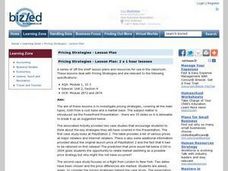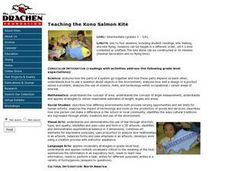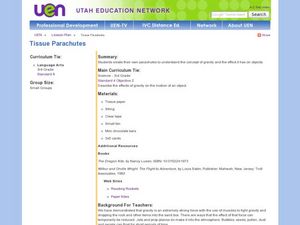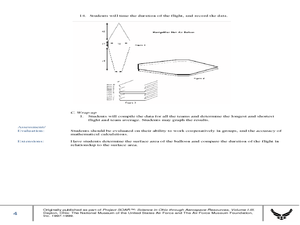Curated OER
Airplanes and Airports: How To Take Off Without Ever Leaving the Ground
Students plan an airport visit. In this Airplanes and Airports lesson, students observe the people, activity, and machinery at airports. Then students compare the characteristics of their observations at the airport. Students make...
Curated OER
Flying with Fractions
Students test their knowledge of the Wright Brothers and their aircraft, and compute ratio of two numbers to determine the ratio between wing span and length of aircraft.
Curated OER
The Flights Of The Phoenix
Students investigate the use of the Phoenix in Japanese and Chinese art while making connections to the use of the Phoenix in the book Fahrenheit 451. This lesson can be adapted for grades 8 through 11 but was originally for 8th grade...
Curated OER
Kites: Patang - The Indian Fighter Kite
Learners investigate the history of fighter kites and build their own. In this aeronautics lesson, students discover how other countries utilize fighter kites and where they originated. Learners create their own fighter kites in class...
Curated OER
Aerodynamics
Students discover the basic principles of aerodynamics, including the roles and identity of natural forces involved. They examine how the force of gravity is overcome by the curved shape of an airplane wing and air pressure.
Curated OER
Building And Launching a Model Rocket
Students are introduced to the basic parts of rockets and the physical forces at work in the flight of rockets. They build and launch a model rocket and discuss the challenges of launching a real rocket.
Curated OER
Up, Up, and Away
Students investigate the laws of physics that govern the flight of helicopters and airplanes. They build and launch a model rotor, simulating rotors used on helicopters to provide lift.
Curated OER
Exploring the MapleCopter
Study explore the motion of maple seeds and design experiments to explain their spinning flight patterns. They make observations, explain ideas of motion, use models, analyze previous reports and experiments, identify relevant factors...
Curated OER
Airplane Wings
Students examine the aerodynamics of a wing and how it generates lift. In this flight activity students complete several experiments including how to build a paper plane and how airfoils affect performance.
Curated OER
Determining Importance
Students observe pieces of art and look for the principle story the artwork portrays. They compare the techniques artists and authors use to focus on and support these essential stories. They create a piece of art that portrays a given...
Curated OER
Pricing Strategies
Young scholars examine the principles companies use to price their problems. They discover the difference between cost based and market based pricing. They identify other factors that go into pricing decisions.
Curated OER
Teaching the Kono Salmon Kite
Students complete several student readings involving kite making and kite flying. They analyze how the parts of a system go together and how these parts depend on each other. They comprehend how different environments both provide...
Curated OER
Human Needs
Students investigate human needs and how they have adapted to different environments. They complete an experiment to discover the effect of stress on muscles. They use the food pyramid to create a plan for healthy eating.
Curated OER
How Do Airplanes Stay off the Ground?
Students use balloons and string to duplicate Bernoulli's Principle of wing shape and its affect on liftoff.
Curated OER
Motion and Gravity
Third graders make parachutes to learn about gravity and the science process. In this gravity lesson, 3rd graders create parachutes and observe their flight in air. Students discuss wind and gravity for the activity.
Curated OER
Up, Up and Away with the Montgolfier Balloon
Students construct hot air balloons. In this science lesson, students assemble their own balloon using tissue paper and glue. They time the duration of the flight, record data and calculate team averages.
NASA
The Lunar Lander – Ascending from the Moon
What angle? Groups determine the height of the lunar lander as it ascends from the surface of the moon and calculate the angle of elevation of the lunar lander at specific times and distances. The provided series of questions lead the...
Institute of Electrical and Electronics Engineers
Water Rocket Launch
How do rockets fly? Teams design, build, and launch a rocket made from a two-liter bottle to explore forces on a rocket such as Newton's Laws of Motion. During the design phase, young engineers draw a diagram of their rocket and include...
Curated OER
Reading Comprehension 3 (Level 7)
Have you ever been in a hot air balloon? Whether your readers are English language learners or native speakers, assess their reading comprehension with this short passage and the seven multiple-choice questions that follow. A detailed...
NASA
Communications and the Lunar Outpost
Can you hear me now? Groups use given information about communication on the moon to determine the maximum distance an astronaut can travel and stay in communication. Using the calculations, they determine what lunar features they can...
NASA
The NBL Pool
That is a lot of water. Class groups explore the size of the NASA's Neutral Buoyancy Pool and calculate the volume of water needed to fill it. They then compare that volume to the amount of water needed to fill a pool the size of a...
Cornell University
Catapults
Ready, aim, fire! Launch to a new level of understanding as scholars build and test their own catapults. Learners explore lever design and how adjusting the fulcrum changes the outcome.
Polar Trec
What Is My Footprint?
How do one's habits and lifestyle choices affect the environment? Through a short online survey, learners will calculate their own carbon footprints then determine how to reduce their impact on the environment through simple steps, such...
NASA
Weightless Wonder
A video of the weightless wonder provides a setting for the math to follow. Groups analyze the graph of a quadratic function that models the path of the C-9 as it gives astronauts the experience of weightlessness. Using a graphing...

























